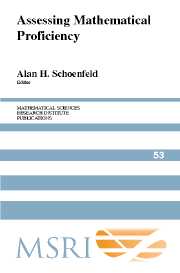Book contents
- Frontmatter
- Contents
- Preface
- Acknowledgments
- Section 1 The Big Picture
- Section 2 Perspectives on Mathematical Proficiency
- 4 What Is Mathematical Proficiency?
- 5 What Is Mathematical Proficiency and How Can It Be Assessed?
- Section 3 What Does Assessment Assess? Issues and Examples
- Section 4 The Case of Algebra
- Section 5 What Do Assessments Assess? The Case of Fractions
- Section 6 The Importance of Societal Context
- Epilogue: What Do We Need to Know? Items for a Research Agenda
- About the Authors
- Subject Index
- Author Index
- Task Index
4 - What Is Mathematical Proficiency?
Published online by Cambridge University Press: 06 July 2010
- Frontmatter
- Contents
- Preface
- Acknowledgments
- Section 1 The Big Picture
- Section 2 Perspectives on Mathematical Proficiency
- 4 What Is Mathematical Proficiency?
- 5 What Is Mathematical Proficiency and How Can It Be Assessed?
- Section 3 What Does Assessment Assess? Issues and Examples
- Section 4 The Case of Algebra
- Section 5 What Do Assessments Assess? The Case of Fractions
- Section 6 The Importance of Societal Context
- Epilogue: What Do We Need to Know? Items for a Research Agenda
- About the Authors
- Subject Index
- Author Index
- Task Index
Summary
In February of 2004 Alan Greenspan told the Senate Banking Committee that the threat to the standard of living in the U.S. isn't from jobs leaving for cheaper Asian countries. Much more important is the drop in U.S. educational standards and outcomes.
“What will ultimately determine the standard of living of this country is the skill of the people,” Greenspan pointed out. … “We do something wrong, which obviously people in Singapore, Hong Kong, Korea and Japan do far better. Teaching in these strange, exotic places seems for some reason to be far better than we can do it.”
[Mukherjee 2004]Current estimates by Forrester Research (Cambridge, MA) are that over the next 15 years at least 3.3 million jobs and 136 billion dollars in wages will move to Asia.
Introduction
The first job of our education system is to teach students to read, and the majority of students do learn this. The second thing the system must do is teach students basic mathematics, and it is here that it fails. Before we can even think about fixing this—something we have been trying to do without success for many years—we must answer two basic questions.
What does it mean for a student to be proficient in mathematics?
How can we measure proficiency in mathematics?
These are hard questions. The initial question is difficult because mathematics is one of the most seriously misunderstood subjects in our entire K–12 educational system.
- Type
- Chapter
- Information
- Assessing Mathematical Proficiency , pp. 31 - 58Publisher: Cambridge University PressPrint publication year: 2007
- 8
- Cited by



